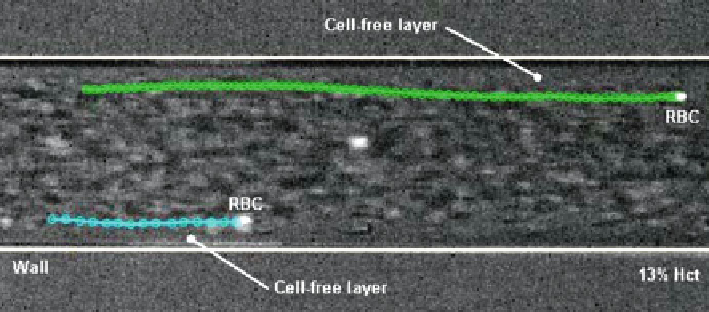Biomedical Engineering Reference
In-Depth Information
Fig. 9.17
Trajectory of labelled RBCs flowing nearby the cell-free layer (adapted by [
29
])
9.4.3.6
In Vitro Blood Flow Through Complex Geometries
Past studies on blood flow through glass micro-channels and in micro-vessels have
yielded conflicting results with respect to flow resistance and deformability of RBCs
[
42
,
48
]. However, observed in vivo/in vitro discrepancies have not yet been con-
vincingly explained by the research, which is restricted to straight rigid glass micro-
channels. One possible way of understanding observed in vivo/in vitro discrepancies
is by using PDMS micro-channels fabricated by a soft lithographic technique
[
27
,
34
]. By using this kind of technique it is possible to fabricate biomimetic
PDMS micro-channels with complex geometries similar to human blood arterioles
and capillary networks. In a very recent study performed by Leble et al. [
20
-
22
] the
effects were investigated of bifurcations (diverging and converging) on the flow
behaviour of both fluorescent particles suspended in pure water (PW) and RBCs in
concentrated suspensions (14%Hct). A very dominant phenomenon was observed in
blood flow behaviour at the region of the converging bifurcation apex. At this region,
the formation of a clear triangular CFL was observed, the layer tending to propagate
along the centre of the micro-channel. Ishikawa et al. [
17
] and Leble et al. ([
20
-
22
],
2012) give more detailed information about this phenomenon.
Recently, Fujiwara et al., by using a confocal micro-PTV system have investigated
the flow behaviour of RBCs in a micro-channel with a stenosis [
11
]. The influence of a
stenosis (70%) on the trajectories of individual RBCs was investigated in a
concentrated suspension of up to 20% Hct. For 10% Hct the results indicated that
healthy RBC trajectories have a tendency to become asymmetric before and after the
stenosis whereas trajectories of particles suspended in pure water tend to be almost
symmetric. Furthermore, the influence of the deformability of RBCs on the CFL
thickness was also investigated. Fujiwara et al. have demonstrated that deformability
plays a crucial role on the asymmetry of the CFL thickness. Generally, they have
concluded that the motions of RBCs are strongly influenced not only by RBC
deformability but also by the Hct and channel geometry [
11
].

Search WWH ::

Custom Search